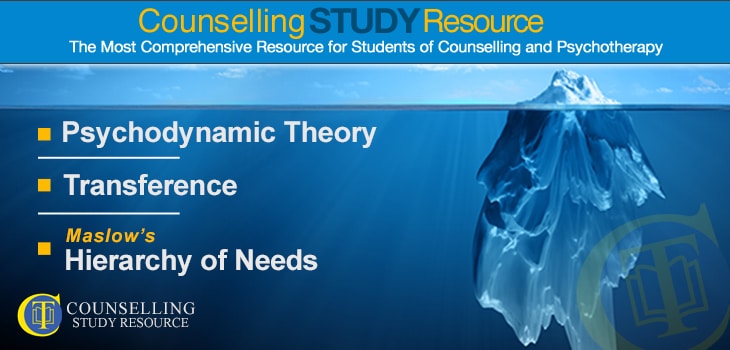In episode 75 of the Counselling Tutor Podcast, Ken Kelly and Rory Lees-Oakes talk about psychodynamic theory. ‘Practice Matters’ then delves into transference, before the presenters discuss Abraham Maslow’s hierarchy of needs.
Psychodynamic Theory (starts at 1.36 mins)
Psychodynamic theory was originally developed by Sigmund Freud, the father of talking therapies. This represented a move away from the traditional medical model of treating mental-health problems with medication. Freud’s work was based on the idea of drive theory (i.e. looking at what drives humans).
Freud proposed a tripartite model of personality – comprising the id, ego and superego – in contrast to the humanistic model of an organismic whole. He believed that sexual drives and stages were important; he saw women as very different from men, even proposing the term ‘hysteria’ as female-specific. Those receiving therapy were often referred to as ‘patients’ or ‘analysands’ rather than as ‘clients’.
Psychodynamic theory has informed other developments in psychotherapeutic theory, for example Eric Berne’s work on transactional analysis; he and Carl Jung always worked together before going their separate ways. It is in psychodynamic approaches that practitioners tend to be referred to as ‘psychotherapists’ rather than ‘counsellors’.
While counselling focuses on resolving specific issues and tends to be fairly short-term, psychotherapy (which uses the technique of psychoanalysis) is often about sorting out the client’s whole life (involving bringing early memories back into the conscious mind). As such, it tends to require a much longer course of therapy.
Transference (starts at 12.32 mins)
The importance of transference – a subconscious reminder of a past relationship – in the counselling room can be underestimated. Rory describes an example of a student experiencing transference towards him, as he reminded her of her father. When this happens, there is a danger that the person experiencing transference discounts the other person, making assumptions about them that are based on past rather than present experience.
Rory gives some pointers on clues that transference is occurring in the therapy room
These include when the client becomes:
- angry at you
- childlike or coy in your company
- fearful (of either your physical presence or the idea that you might judge them).
While these signs suggest that transference may be happening and be outside the awareness of the client, it can sometimes be overt. For example, the client might say: ‘You sound just like my dad.’
Maslow’s Hierarchy of Needs (starts at 19.03 mins)
The hierarchy of needs – sometimes known as ‘Maslow’s pyramid’ – is one of the key concepts in humanistic psychology (the third force in psychology, after psychodynamics and behaviourism.
Rory explains the structure of the hierarchy, moving from physiological needs at the base to self-actualisation at the top. It is possible to move to the next level only once your needs at the lower level have been met. Abraham Maslow influenced the work of Carl Rogers, in particular in the seven stages of process (which track people’s development, including clients in counselling).
You’ll find various resources on Maslow’s hierarchy on the Counselling Tutor website (you can use our new search facility). Given that lack of prejudice is an important part of self-actualisation, you might also find it useful to refer to episode 74 of the Counselling Tutor podcast on self-concept. Awareness of self is key to moving towards self-actualisation.


